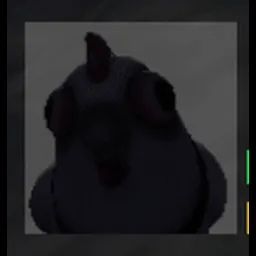Player Hud Shaders
In the player hud, shader effects are used to provide immediate feedback when the player is hurt or healed. These effects are applied to a ColorRect node overlaying the player icon.
- Hurt Shader: Uses chromatic aberration and color blending to create a red-tinted, distorted effect, to signal damage.
- Heal Shader: Applies a colored blur and glow to signal recovery. The shader uses a Gaussian blur, which is a smoothing filter that averages neighboring pixels with weights from a Gaussian distribution, meaning pixels closer to the center have a higher influence on the final color. Together, these create a soft, glowing effect on the player icon when they are healed.
In addition to the shaders, a background color is applied to the background ColorRect node. The color is set to a different color when the player is hurt or healed. All shader and color effects are changeable via @export variables in the editor.
Hurt Shader
Section titled “Hurt Shader”
shader_type canvas_item;
uniform sampler2D screen_texture : hint_screen_texture, filter_linear_mipmap, repeat_enable;uniform vec3 hurt_color = vec3(0.8, 0.0, 0.0);uniform float overlay_alpha : hint_range(0.0, 1.0) = 0.5;uniform float aberration_strength : hint_range(0.0, 1.0) = 0.015;uniform float displacement_strength : hint_range(0.0, 0.05) = 0.01;uniform vec2 abberation_offset = vec2(0.5);uniform float time;
void fragment() { vec2 uv = SCREEN_UV;
// Add a subtle displacement. Higher weight for uv, but make it slightly different uv += vec2( sin(uv.y * 50.0 + time * 5.0), cos(uv.x * 50.0 + time * 5.0) ) * displacement_strength;
// Chromatic aberration offsets vec2 offset = (uv - abberation_offset) * aberration_strength;
// Sample each channel with a slight offset float r = texture(screen_texture, uv + offset).r; float g = texture(screen_texture, uv).g; float b = texture(screen_texture, uv - offset).b;
vec3 aberrated_color = vec3(r, g, b);
// Compute difference between channels float diff = abs(r - b); // Blending the chromattic effect with the hurt color float blend_factor = clamp(1.0 - diff * 10.0, 0.0, 1.0); vec3 final_color = mix(aberrated_color, hurt_color, blend_factor);
COLOR = vec4(final_color, overlay_alpha);}-
Shader Parameters:
hurt_color: The color used for the hurt effect.overlay_alpha: The alpha value for the overlay, controlling its transparency.aberration_strength: Controls the strength of the chromatic aberration effect.displacement_strength: Controls the strength of the displacement effect.abberation_offset: The offset for the chromatic aberration effect.time: The time value used for animating the displacement effect.
-
Shader Logic:
- The shader samples the screen texture and applies chromatic aberration and displacement effects to create a distorted, red-tinted effect.
- The final color is a blend of the aberration color and the specified hurt color.
Heal Shader
Section titled “Heal Shader”
Based on the gaussian blur shader by crisp_lad.
shader_type canvas_item;
uniform sampler2D screen_texture : hint_screen_texture, repeat_disable, filter_nearest;uniform float blur_strength : hint_range(0.1, 5.0) = 2.3;uniform float glow_intensity : hint_range(0.0, 5.0) = 1.8;uniform vec3 heal_color : source_color = vec3(0.0, 1.0, 0.4);uniform float overlay_alpha : hint_range(0.0, 1.0) = 0.5;
// Formula stolen from the internetfloat gaussianDistribution(float x, float STD) { return exp(-(x*x)/(2.0*STD*STD))/(sqrt(2.0*PI)*STD);}
vec4 gaussianGlow(sampler2D sampler, vec2 pos, vec2 pixel_size, float sigmaUsed, int radius) { vec4 blurredPixel = vec4(0.0); float total_weight = 0.0;
// Increased radius multiplier for more pronounced blur int actualRadius = int(round(4.0 * blur_strength));
for(int i = -actualRadius; i <= actualRadius; i++) { for(int j = -actualRadius; j <= actualRadius; j++) { vec2 offset = vec2(float(i), float(j)) * pixel_size; vec2 samplePos = pos + offset;
// Calculate 2D Gaussian weight float weight = gaussianDistribution(float(i), sigmaUsed) * gaussianDistribution(float(j), sigmaUsed);
blurredPixel += texture(sampler, samplePos) * weight; total_weight += weight; } }
blurredPixel /= total_weight; return blurredPixel;}
void fragment() { // Get the blurred result vec4 blurred = gaussianGlow(screen_texture, SCREEN_UV, SCREEN_PIXEL_SIZE, blur_strength, int(round(4.0 * blur_strength)));
// Apply glow color and intensity vec3 glow = blurred.rgb * heal_color * glow_intensity;
// Maintain alpha from original blur float alpha = max(blurred.a, overlay_alpha);
COLOR = vec4(glow, alpha);}-
Shader Parameters:
blur_strength: Controls the strength of the blur effect.glow_intensity: Controls the intensity of the glow effect.heal_color: The color used for the heal effect.overlay_alpha: The alpha value for the overlay, controlling its transparency.
-
Shader Logic:
- The shader samples the screen texture and applies a Gaussian blur to create a glowing effect.
- The final color is a blend of the blurred color and the specified heal color.